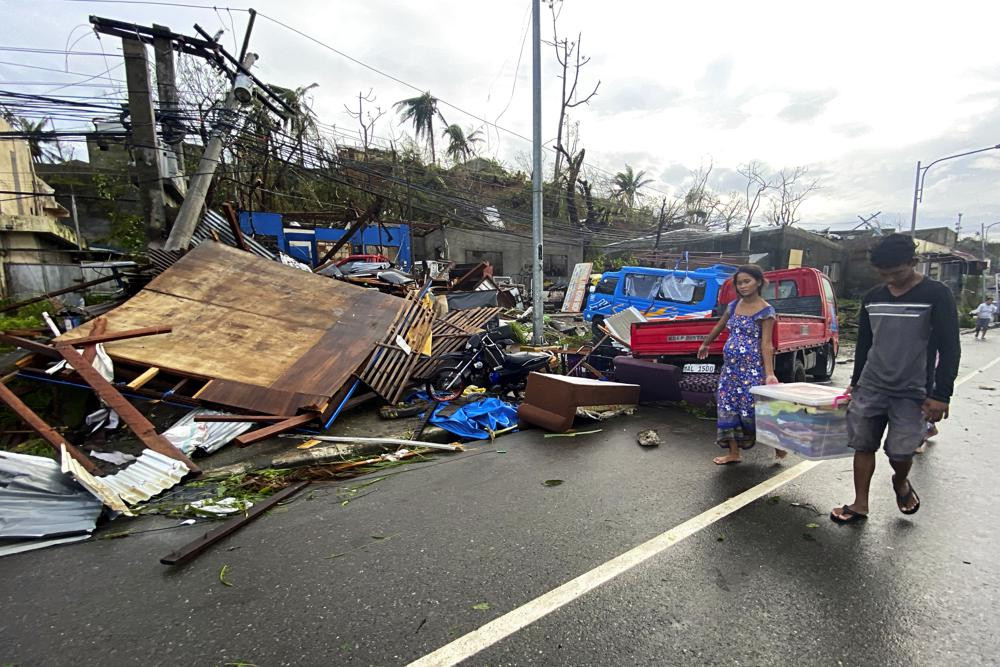A powerful typhoon left at least 19 people dead, knocked down power and communications in entire provinces and wrought widespread destruction mostly in the central Philippines, officials said Saturday. A governor said her island has been “leveled to the ground.”
Typhoon Rai blew away Friday night into the South China Sea after rampaging through southern and central island provinces, where more than 300,000 people in its path were evacuated to safety in advance in a pre-emptive move officials say may have saved a lot of lives.
At its strongest, Rai packed sustained winds of 195 kilometers (121 miles) per hour and gusts of up to 270 kph (168 mph), one of the most powerful in recent years to hit the disaster-prone Southeast Asian archipelago, which lies between the Pacific Ocean and the South China Sea. The typhoon slammed into the country’s southeastern coast Thursday but the extent of casualties and destruction remained unclear two days after with entire provinces still without power and cellphone connection.
The national police reported at least 19 dead but did not provide other details. The government’s main disaster-response agency reported a lower death toll of 12, mostly villagers hit by falling trees, because it said it had to carefully validate each death.
Officials on Dinagat Islands, one of the first provinces to be lashed by the typhoon’s ferocious winds, remained cut off Saturday due to downed power and communication lines. But its governor, Arlene Bag-ao, managed to post a statement on the province’s website to say that the island of about 180,000 “has been leveled to the ground.” She pleaded for food, water, temporary shelters, fuel, hygiene kits and medical supplies. She said only a few casualties have been reported in the capital so far because other towns remain isolated.
“We may have survived, but we cannot do the same in the coming days because of our limited capacities as an island province,” Bag-ao said, adding some of Dinagat’s hospitals could not open due to damage. “Most of our commercial and cargo vessels ... are now unsuitable for sea voyages, effectively cutting us off from the rest of the country.”
Vice Gov. Nilo Demerey managed to reach a nearby province and told DZMM radio network that at least six residents died and that “almost 95% of houses in Dinagat have no roof,” and even emergency shelters were destroyed.
“We’re currently doing repairs because even our evacuation centers were destroyed. There are no shelters, the churches, gymnasium, schools, public markets and even the capitol were all shattered,” Demerey said.
Pictures posted on Dinagat’s website show low-slung houses with roofs either blown off or damaged and surrounded by tin roof sheets and debris. The nearby island of Siargao, known as the surfing capital of the Philippines, also was pummeled by the typhoon.
In central Bohol province, which was directly hit by the typhoon, the coast guard said its personnel on board rubber boats rescued residents who were trapped on roofs and trees, as waters rose rapidly. It released footage showing coast guard staff helping people from the roof of a house nearly engulfed by brownish floodwater to a rubber boat. They also help a villager climb down from a tree above the floodwater while another man, also wearing an orange life vest, waits for his turn.
With government contingency funds used for the coronavirus pandemic, President Rodrigo Duterte said he would look for money to help the provinces. He planned to visit the devastated region this weekend.
About 20 storms and typhoons batter the Philippines each year. The archipelago is located in the seismically active Pacific “Ring of Fire” region, making it one of the world’s most disaster-prone countries.

